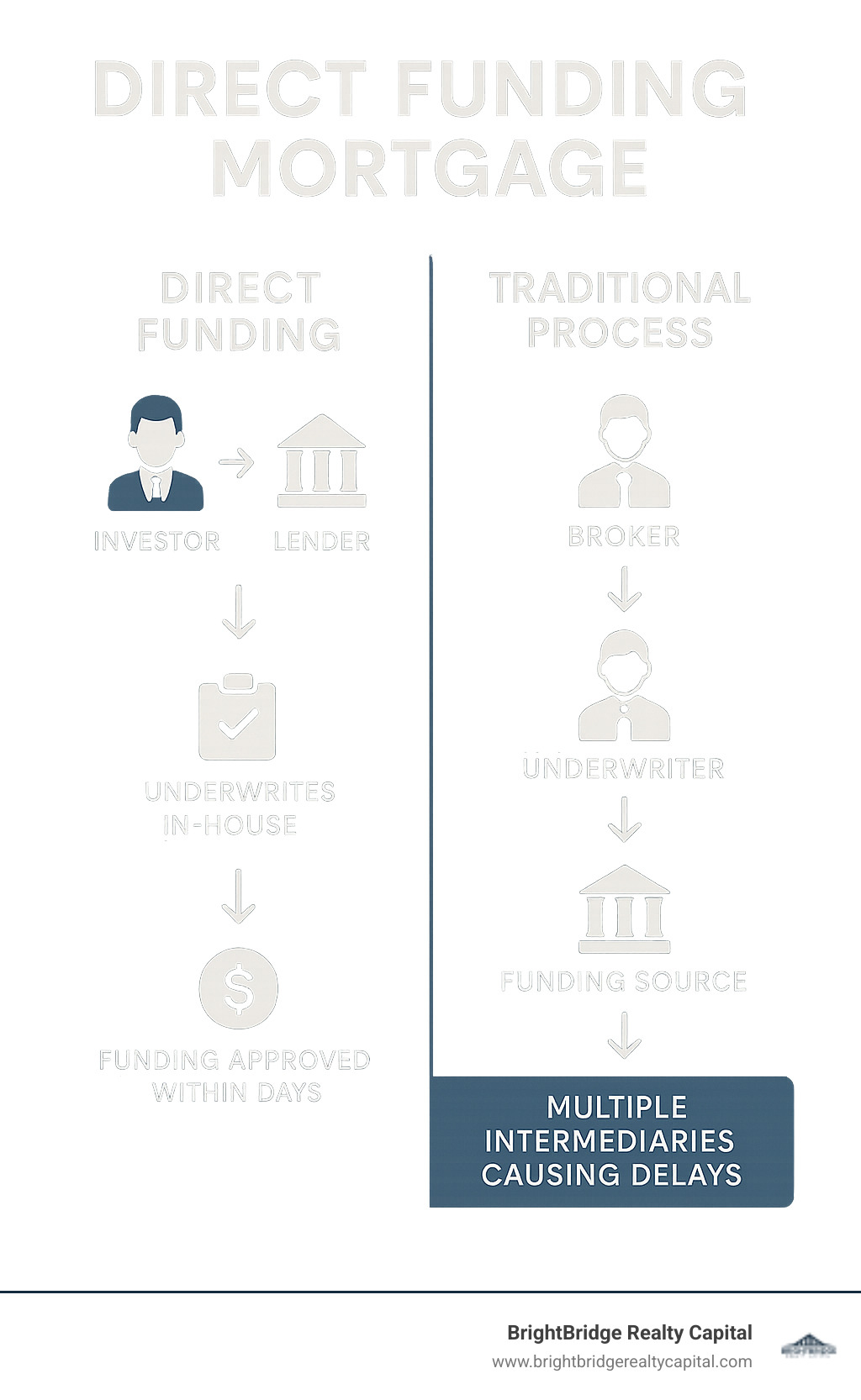Direct Funding Mortgages Explained: Faster, Easier, Better?

Why Direct Funding Mortgages Are Changing Real Estate Finance
A direct funding mortgage is a loan where you work directly with the lender who funds your loan, completely skipping the brokers and intermediaries that complicate traditional financing. For real estate investors, this streamlined approach is more than a convenience—it is a strategic advantage that can cut weeks off your closing time, reduce cumbersome fees, and provide a clear, predictable path from application to funding.
Quick Direct Funding Mortgage Overview:
- What it is: A loan originated, underwritten, and funded by a single lending institution, eliminating middlemen.
- Speed: The primary advantage. Pre-approval can occur in minutes, with full funding often available in as few as 3-10 business days.
- Benefits: Enjoy direct communication with decision-makers, experience faster and more certain closings, and benefit from a transparent fee structure without hidden broker charges.
- Best for: Real estate investors, house flippers, and landlords managing rental portfolios who require speed and certainty to seize market opportunities.
- Loan amounts: Typically range from $50,000 to over $3,000,000, depending on the lender and the scope of the project.
The traditional mortgage process is notoriously fragmented, often involving a dizzying array of parties: loan officers, brokers, processors, multiple underwriters, and separate funding sources. This complex chain creates delays, communication gaps, and opportunities for error. In contrast, direct funding mortgages consolidate this entire workflow under one roof. Leading direct lenders have funded tens of billions in loans this way, with some able to deposit funds in your account within just a few business days of approval.
For a real estate investor, this speed is critical. When you uncover a prime investment property that requires a quick close, waiting the standard 30-45 days for traditional financing is not an option—it often means losing the deal to a cash buyer or a more agile competitor. Direct lenders like BrightBridge Realty Capital are built to serve the specific needs of investors, offering specialized products such as fix-and-flip loans with competitive rates (starting around 8.99%) and DSCR loans designed for cash-flowing rental properties.
I'm Daniel Lopez, a loan officer at BrightBridge Realty Capital, where I've helped countless investors leverage direct funding mortgage solutions to grow their real estate portfolios. My experience covers both residential and commercial transactions, with a specialized focus on structuring creative financing that accommodates aggressive timelines and unique property challenges, ensuring my clients never miss an opportunity due to slow-moving capital.
The Evolution of Mortgage Lending: From Traditional to Direct
The mortgage industry has undergone significant change over the past two decades, driven by technological advances, changing consumer expectations, and market pressures. Traditional mortgage lending, which dominated the landscape for generations, was built around a complex ecosystem of intermediaries, each serving a specific function but also adding layers of complexity and potential delays.
In the traditional model, a borrower might start with a mortgage broker who shops their application to multiple lenders. Once a lender is selected, the file moves through various departments: processing, underwriting, appraisal coordination, and finally to a separate funding department or even an external funding source. Each handoff represents a potential point of failure, miscommunication, or delay. Documents can be lost, requirements can change between departments, and borrowers often find themselves repeating the same information to multiple parties.
The direct funding model emerged as a response to these inefficiencies. By consolidating all functions under one roof, direct lenders can maintain better control over the entire process, from initial application to final funding. This vertical integration allows for better communication, faster decision-making, and a more consistent borrower experience.
The shift toward direct lending has been particularly pronounced in the real estate investment sector, where speed and certainty are paramount. Investment properties often require quick closings to secure favorable purchase prices or to take advantage of time-sensitive market opportunities. Traditional lenders, with their lengthy approval processes and rigid requirements, often cannot meet these demands.
Market Dynamics Driving Direct Funding Adoption
Several market forces have accelerated the adoption of direct funding mortgages across various segments of the real estate market. The competitive nature of today's real estate environment, particularly in hot markets, has created a premium on speed and certainty. Sellers increasingly favor buyers who can demonstrate quick, reliable financing over those dependent on lengthy traditional mortgage processes.
The rise of institutional investors in residential real estate has also contributed to this trend. These sophisticated buyers require financing partners who can match their operational speed and scale. Direct lenders, with their streamlined processes and flexible underwriting criteria, are better positioned to serve these demanding clients.
Technology has played a crucial role in enabling the direct funding model. Advanced underwriting software, automated valuation models, and digital document processing have eliminated many of the manual bottlenecks that once made direct lending impractical. Today's direct lenders can process applications, verify income and assets, order appraisals, and make funding decisions with unprecedented speed and accuracy.
The regulatory environment has also evolved to support more efficient lending practices. While consumer protection remains paramount, regulators have recognized the benefits of streamlined lending processes and have worked to remove unnecessary barriers that once slowed the mortgage process.
Understanding the Direct Funding Advantage
While the model is particularly powerful for investors, it is also reshaping expectations for everyday borrowers. The prevalence of mobile banking, e-signatures, and immediate document uploads means that consumers now expect the same frictionless experience from their mortgage provider as they do from any modern fintech app. In a market where speed and certainty can mean the difference between landing a dream property or walking away disappointed, a direct funding approach feels almost tailor-made for the 2025 digital-first landscape.
From a macroeconomic standpoint, disintermediation has been happening across the financial sector for years. Peer-to-peer payment tools, online brokers, and the rise of alternative lending platforms have conditioned borrowers to expect fewer middle layers. Direct mortgages are a natural extension of that shift, removing what the industry once considered "necessary friction" and replacing it with transparency and direct accountability. For a deeper historical look at how mortgage lending has evolved, see the entry on mortgage loan.
Moreover, the competitive real estate markets in major hubs—New York, Austin, Miami, and Los Angeles—reward buyers who can demonstrate proof of funds or iron-clad financing within days. BrightBridge's headquarters in New York City positions our underwriting team in the heart of one of the most dynamic property markets in the world, allowing us to spot trends early and calibrate our lending guidelines to meet emerging investor needs.
The Technology Behind Direct Funding Success
The success of direct funding mortgages is largely enabled by sophisticated technology platforms that automate and streamline traditional lending processes. Modern direct lenders invest heavily in proprietary software systems that can process applications, verify borrower information, and make preliminary underwriting decisions in real-time.
Artificial intelligence and machine learning algorithms play increasingly important roles in this process. These systems can analyze borrower profiles, property characteristics, and market conditions to assess risk and determine appropriate loan terms almost instantaneously. This technological capability allows direct lenders to provide preliminary approvals within minutes of application submission, a feat that would be impossible with traditional manual underwriting processes.
Document processing has been revolutionized through optical character recognition (OCR) and automated data extraction technologies. Borrowers can upload financial documents, tax returns, and bank statements through secure portals, and the system can immediately extract relevant information and verify it against third-party databases. This eliminates the need for manual data entry and reduces the potential for human error.
Integrated communication platforms ensure that all parties involved in the loan process—borrowers, loan officers, underwriters, and closing coordinators—have access to real-time updates and can communicate efficiently. This transparency reduces anxiety for borrowers and allows for quick resolution of any issues that may arise.
Risk Management in Direct Funding
One might assume that the speed of direct funding mortgages comes at the expense of proper risk assessment, but sophisticated direct lenders have developed robust risk management frameworks that actually improve their ability to make sound lending decisions. By maintaining control over the entire lending process, direct lenders can implement consistent risk assessment criteria and ensure that all loans meet their standards.
Direct lenders often specialize in specific market segments, allowing them to develop deep expertise in assessing the unique risks associated with their target borrowers and property types. For example, a lender focused on real estate investors will have extensive experience evaluating rental property cash flows, renovation costs, and local market dynamics—knowledge that generalist lenders may lack.
The use of advanced analytics and predictive modeling allows direct lenders to assess risk more accurately than traditional methods. These systems can analyze vast amounts of data, including borrower credit history, property characteristics, local market trends, and economic indicators, to predict loan performance with greater precision.
Portfolio lending, where the lender retains loans on their books rather than selling them to secondary markets, aligns the lender's interests with loan performance. This creates strong incentives for careful underwriting and ongoing borrower relationships.

Cost Structure and Pricing Advantages
The streamlined nature of direct funding mortgages often translates into cost advantages for borrowers. By eliminating intermediaries, direct lenders can offer more competitive rates and lower fees. Traditional mortgage brokers typically charge origination fees or receive yield spread premiums from lenders, costs that are ultimately passed on to borrowers. Direct lenders can eliminate these middleman costs and pass the savings on to their clients.
The operational efficiency of direct lending also contributes to cost savings. Automated processes, reduced manual labor, and faster turnaround times all contribute to lower operational costs, which can be reflected in more competitive pricing. Additionally, the ability to make quick decisions and close loans rapidly can save borrowers money in terms of reduced carrying costs, shorter bridge loan periods, and the ability to secure time-sensitive deals.
Transparency in pricing is another advantage of the direct funding model. With no hidden broker fees or complex fee structures involving multiple parties, borrowers can better understand exactly what they're paying for and why. This transparency builds trust and allows for more informed decision-making.
Future Trends in Direct Funding
The direct funding mortgage market continues to evolve, with several trends shaping its future development. The integration of blockchain technology promises to further streamline the lending process by creating immutable records of transactions and enabling smart contracts that can automatically execute loan terms when conditions are met.
Open banking initiatives, which allow secure sharing of financial data between institutions, will enable even faster verification of borrower financial information. This could reduce the documentation requirements for borrowers while maintaining rigorous underwriting standards.
The expansion of alternative credit scoring models will allow direct lenders to serve borrowers who might not qualify for traditional financing. By considering factors beyond traditional credit scores, such as rental payment history, utility payments, and other financial behaviors, lenders can make more nuanced risk assessments.
Environmental, social, and governance (ESG) considerations are becoming increasingly important in lending decisions. Direct lenders are beginning to offer preferential terms for energy-efficient properties or sustainable development projects, reflecting growing awareness of climate-related risks and opportunities.
Key direct funding mortgage vocabulary:
What is a Direct Funding Mortgage and How Does it Work?
Think of a direct funding mortgage as the express lane for your real estate financing. Instead of your application taking a long and winding road through brokers, banks, and third-party funding sources, you work directly with the institution that will actually provide your loan money. It's the difference between buying a product straight from the factory versus navigating a chain of distributors and retailers, each adding time and cost to the process.

The Core Concept of Direct Lending
At its heart, direct lending means you're working with the lender as the source of your funds. The same company that takes your application is the one that underwrites it, makes the approval decision, and ultimately wires the funds for your closing. There is no hand-off of your sensitive financial file from one company to another, and no waiting for an unknown, outside committee to give the final sign-off.
Our in-house underwriting process is a key component that keeps everything under one roof. Our team of underwriters works alongside our loan officers, reviewing your documents, assessing the property's value, and making funding decisions based on our own established guidelines and capital reserves. This creates a cohesive and streamlined experience where you have direct communication with the people who are actively working on your loan.
Having a single point of contact throughout your mortgage journey eliminates the confusion and frustration that plagues traditional lending. When you call with a question, you're not routed to a call center or a processor who is unfamiliar with your file; you're speaking to someone who knows your deal and can provide clear, actionable answers. Because we fund loans from our own capital reserves, we maintain absolute control over the timeline and can move with a speed and certainty that lenders dependent on the secondary market simply cannot match.
The direct lending model represents a fundamental shift in how mortgage financing is structured and delivered. Traditional mortgage lending evolved during an era when information moved slowly, verification processes were manual, and geographic limitations required local intermediaries to connect borrowers with distant capital sources. Today's technology has eliminated many of these constraints, enabling lenders to serve borrowers directly regardless of location while maintaining rigorous underwriting standards.
This evolution has been particularly beneficial for sophisticated borrowers who understand their financing needs and prefer to work directly with decision-makers. Real estate investors, in particular, have acceptd direct lending because it aligns with their business-oriented approach to property acquisition and portfolio management. Rather than navigating the consumer-focused processes of traditional mortgage brokers, investors can work with lenders who understand their unique requirements and can structure financing accordingly.
The Operational Framework of Direct Funding
Understanding how direct funding mortgages operate requires examining the integrated systems and processes that make rapid lending decisions possible. Unlike traditional lenders who may outsource various functions to third parties, direct lenders maintain comprehensive in-house capabilities that span the entire lending lifecycle.
The application process begins with sophisticated intake systems that can capture and organize borrower information efficiently. Modern direct lenders use secure online portals where borrowers can upload documents, track application progress, and communicate with their lending team. These systems are designed to minimize data entry requirements while ensuring that all necessary information is captured accurately.
Credit analysis in the direct lending environment goes beyond traditional credit scoring models. While credit scores remain important, direct lenders often employ more nuanced approaches that consider the specific context of the borrower's situation. For real estate investors, this might include analysis of existing property portfolios, rental income stability, and market expertise. For business owners, it could involve evaluation of business cash flows, industry trends, and management experience.
Property evaluation is another critical component of the direct funding process. Direct lenders typically maintain relationships with networks of qualified appraisers and inspectors who can provide rapid property assessments. Some lenders also use automated valuation models (AVMs) and broker price opinions (BPOs) to supplement traditional appraisals, particularly for investment properties where speed is crucial.
The underwriting process in direct lending environments is characterized by decision-maker accessibility and flexibility. Senior underwriters and loan officers work closely together, often in the same physical or virtual workspace, enabling real-time consultation and problem-solving. This collaborative approach allows for creative solutions to unique borrower situations that might be difficult to address in more bureaucratic lending environments.
How Direct Funding Mortgages Stand Out
The true power of a direct funding mortgage is revealed in its simplicity and speed. While a traditional mortgage can feel like a black box, direct lending offers a transparent, linear path from application to closing.
| Feature | Description |
|---|---|
| Direct communication | You work directly with the decision-makers, eliminating the delays and miscommunications caused by middlemen. |
| Streamlined process | A single, integrated company handles every step from application and underwriting to appraisal and funding. |
| Fast approvals | In-house underwriting and control over capital mean decisions are made in hours or days, not weeks. |
| Transparent fees | With no brokers or intermediaries, you avoid paying extra commissions or hidden charges. It's always wise for borrowers to understand the components of their mortgage payment, which you can explore with tools like a government-provided mortgage calculator. |
| Strong lender relationship | You build a direct relationship with your capital partner, which is invaluable for future deals and portfolio growth. |
This integrated approach removes the most common frustrations of mortgage lending. No intermediaries means no one is taking an unnecessary cut of your deal or adding pointless delays to the timeline. You cultivate a direct relationship with your lender, which is a powerful asset for real estate investors who depend on a reliable financing partner to execute their strategy across multiple projects.
The relationship aspect of direct lending cannot be overstated. When you work with the same lender across multiple transactions, they develop a deep understanding of your investment strategy, risk tolerance, and performance history. This knowledge enables them to make faster decisions on future loans and potentially offer more favorable terms based on your proven track record.
Direct lenders also tend to be more flexible in their approach to unique situations. Because they're not bound by the rigid guidelines of secondary market purchasers, they can consider factors that traditional lenders might overlook. This flexibility is particularly valuable for investors dealing with non-standard properties, complex ownership structures, or time-sensitive opportunities.
The Technology Infrastructure Behind Direct Lending
Modern direct funding mortgages are enabled by sophisticated technology platforms that integrate multiple functions into seamless workflows. These systems represent significant investments by direct lenders in creating competitive advantages through operational efficiency and borrower experience.
Loan origination systems (LOS) serve as the central nervous system of direct lending operations. These platforms manage the entire loan lifecycle from initial application through funding and servicing. Advanced LOS platforms can automatically route applications to appropriate underwriters, trigger required third-party services like appraisals, and generate compliance documentation.
Document management systems ensure that all loan files are organized, accessible, and secure. These systems often include version control, audit trails, and automated compliance checking to ensure that all regulatory requirements are met. Borrowers benefit from these systems through secure portals that provide real-time access to their loan status and document requirements.
Integration with third-party data sources enables rapid verification of borrower information. Credit bureaus, bank account verification services, employment verification systems, and tax transcript services can all be accessed electronically, eliminating the delays associated with manual verification processes.
Communication platforms ensure that all stakeholders remain informed throughout the lending process. Automated notifications keep borrowers updated on application progress, while internal communication tools enable lending team members to collaborate effectively. Some advanced systems include predictive analytics that can identify potential issues before they become problems, enabling proactive resolution.
Who Provides Direct Funding Mortgages?
Direct funding mortgages are typically offered by specialized direct lenders who have built their entire business model around speed and efficiency. These are not your conventional big-box banks, which are often constrained by layers of bureaucracy and rigid, standardized lending criteria. Instead, you will find agile private lending companies and certain specialized financial institutions that prioritize direct relationships with borrowers.
Many of these lenders serve specific niches. Companies focused on real estate investors, such as BrightBridge Realty Capital, possess a deep understanding of the unique challenges and opportunities in the property market. We live and breathe real estate investment, where timing, flexibility, and certainty can make or break a profitable deal.
These specialized lenders have far more flexibility than traditional banks because they are not bound by the same strict regulatory constraints that govern conventional consumer mortgages. They can make common-sense, asset-based decisions quickly and structure loans to fit the specific parameters of your investment, rather than trying to force your unique project into a one-size-fits-all box.
Direct lenders may also leverage technology—automated valuation models, optical character recognition for faster document reads, and secure portals—to deliver a user experience on par with top fintech platforms. The result: approvals that once took 30 days can now be issued in less than 48 hours, and closings that previously stretched into months can wrap up in a single workweek.
The Regulatory Environment for Direct Lending
The regulatory landscape for direct funding mortgages varies depending on the type of lender and the nature of the loans being originated. Traditional banks and credit unions that offer direct funding are subject to comprehensive federal and state banking regulations, including capital requirements, lending limits, and consumer protection laws.
Non-bank direct lenders, which include many specialized real estate investment lenders, operate under different regulatory frameworks. These lenders are typically subject to state licensing requirements and must comply with federal laws such as the Truth in Lending Act (TILA) and the Real Estate Settlement Procedures Act (RESPA) when applicable.
The regulatory environment has generally evolved to support innovation in lending while maintaining appropriate consumer protections. Regulators recognize that overly burdensome requirements can stifle beneficial innovations that improve access to credit and improve borrower experiences.
For commercial and investment property lending, regulations are generally less restrictive than those governing consumer mortgages. This regulatory flexibility enables direct lenders to offer more creative and responsive financing solutions to sophisticated borrowers who don't require the same level of protection as typical homebuyers.
Compliance management is a critical component of successful direct lending operations. Leading direct lenders invest heavily in compliance systems and personnel to ensure that all loans meet applicable regulatory requirements. This investment in compliance infrastructure actually supports faster lending by reducing the need for manual compliance reviews and enabling automated compliance checking.
Market Segments Served by Direct Funding
While direct funding mortgages are often associated with real estate investment lending, the model serves various market segments, each with unique characteristics and requirements. Understanding these segments helps illustrate the versatility and broad applicability of direct lending approaches.
Real estate investors represent the largest and most established segment for direct funding. This includes fix-and-flip investors who need rapid acquisition financing, buy-and-hold investors building rental portfolios, and commercial investors acquiring income-producing properties. These borrowers value speed, flexibility, and the ability to work with lenders who understand their business models.
High-net-worth individuals seeking financing for luxury properties or unique situations often prefer direct lending relationships. These borrowers typically have complex financial profiles that don't fit standard lending criteria, and they value the personalized service and flexibility that direct lenders can provide.
Small business owners seeking commercial real estate financing represent another important segment. These borrowers often need financing that considers both personal and business financial profiles, and they benefit from working with lenders who can evaluate their complete financial picture rather than applying rigid qualification criteria.
Self-employed borrowers and those with non-traditional income sources often find direct lenders more accommodating than traditional banks. Direct lenders can consider alternative documentation and income verification methods that better reflect these borrowers' actual financial capacity.
Finally, while a direct funding mortgage is often associated with investment properties, certain lenders extend the same efficient model to owner-occupied homes, vacation properties, and even small-balance commercial real estate. As regulatory frameworks evolve and technology continues to remove legacy bottlenecks, expect direct lending to become the dominant model for a growing share of the $2-trillion-plus U.S. mortgage market.
The Future of Direct Funding Mortgages
The direct funding mortgage industry continues to evolve rapidly, driven by technological advancement, changing borrower expectations, and competitive pressures. Several trends are shaping the future development of this sector and expanding its reach into new markets and borrower segments.
Artificial intelligence and machine learning are becoming increasingly sophisticated in their ability to assess credit risk and predict loan performance. These technologies enable direct lenders to make more accurate lending decisions while reducing the time required for underwriting. As these systems continue to improve, we can expect even faster approval times and more precise risk pricing.
Blockchain technology holds promise for creating more secure and efficient loan documentation and transfer processes. Smart contracts could automate many aspects of loan servicing and compliance, while distributed ledger systems could provide more secure and transparent record-keeping.
The integration of Internet of Things (IoT) devices and real-time data feeds could revolutionize property valuation and monitoring. Smart home systems, utility usage data, and other real-time information sources could provide lenders with more accurate and current information about property conditions and values.
Regulatory technology (RegTech) solutions are making compliance more efficient and less costly for direct lenders. Automated compliance monitoring, reporting, and documentation systems reduce the burden of regulatory compliance while ensuring that all requirements are met consistently.
The expansion of open banking and data sharing initiatives will enable even more streamlined application and verification processes. As borrowers gain more control over their financial data and can share it more easily with lenders, the application process will become even more efficient while maintaining security and privacy protections.


